The swarm of bees you witness may be alarming, but it is a beautiful sight. This phenomenon usually happens between April and May and is unlikely to occur during rainy days. Western honey bees are less likely to swarm than African honey bees, which have a tendency to swarm more frequently and be more defensive. But why do honey bees swarm? Let’s dive into the reasons and methods below.
Swarming To Make Room
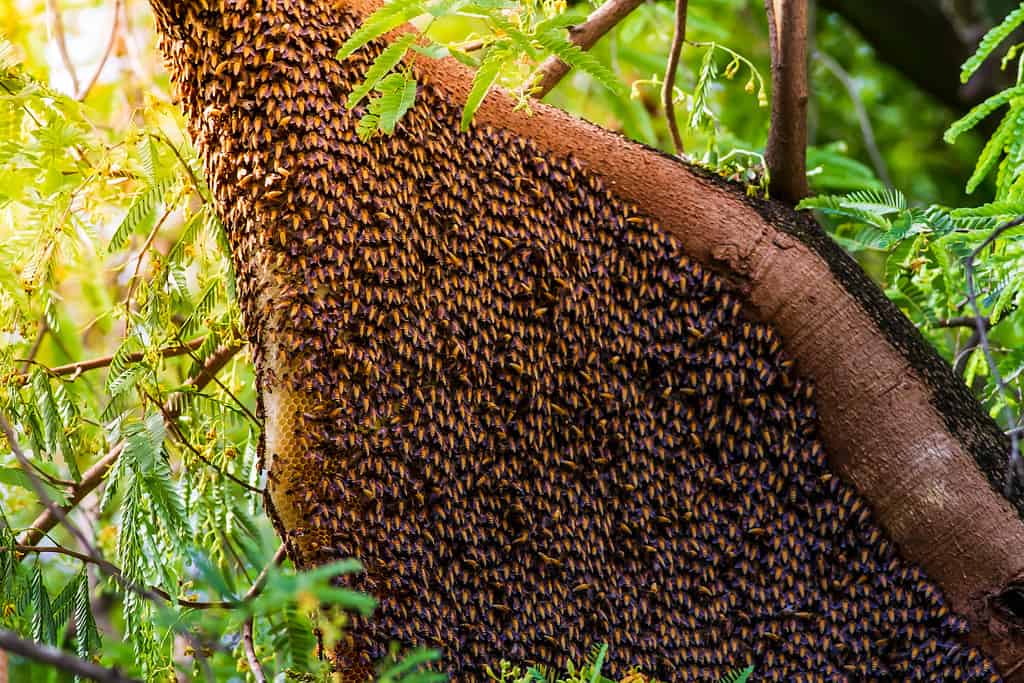
Did you know that honey bees secrete wax from pores on the sides of their bodies to make their nests?
©vivatchai/Shutterstock.com
Honey bees, scientifically known as Apis mellifera, exhibit a fascinating behavior called swarming when their hive becomes overcrowded. This natural phenomenon involves the division of the bee colony into two or more groups, with one group opting to stay in the existing hive while another embarks on an adventurous journey to seek out a new home.
The decision to swarm is not taken lightly by these remarkable insects. Worker bees within the hive possess an innate ability to detect when living conditions have become cramped and uncomfortable due to excessive population growth. As they sense that space is dwindling and resources are becoming scarce, a signal spreads throughout the colony, indicating that it’s time for relocation.
When this pivotal moment arrives, worker bees begin diligently preparing for swarming by taking strategic measures. One of their first tasks is creating specialized structures known as queen cells, within which fertile eggs will be laid by the reigning queen herself. These queen cells serve as incubators for future queens and symbolize hope for rejuvenating and expanding their community.
Swarming serves several vital purposes beyond simply relieving overcrowding concerns within hives. Not only does it allow honeybees to establish new colonies in unoccupied areas, but it also ensures genetic diversity.
Swarming to Make Babies

Queen bees can lay over 3,000 eggs in a single day.
©iStock.com/Inventori
Swarming is a fascinating and essential behavior in the world of honey bees. It serves as their natural means of reproduction, ensuring the survival and expansion of their species. When a colony swarms, it undergoes a remarkable process where it splits into two or more distinct colonies.
During this captivating phenomenon, the reproductive swarms venture out from their original nest to seek new horizons. They settle approximately 50-100 feet away from their former home for a few days before embarking on an exciting journey toward a fresh nesting site. To guide them on this quest, scout bees play a crucial role.
These intrepid scouts diligently explore the surrounding environment in search of suitable cavities to construct the swarm’s future dwelling. With keen eyes and impressive navigational skills, they scour through trees, rock crevices, or even man-made structures like abandoned buildings or chimneys.
Once successful, scouts discover potential nesting sites that meet specific criteria such as size, protection from elements and predators, ventilation, and accessibility to resources like nectar and pollen nearby. They return triumphantly to share their findings with fellow bees back at the temporary settlement.
The communication between scout bees and other members of the swarm is awe-inspiring. Through intricate dance-like movements known as waggle dances combined with chemical signals called pheromones, these industrious messengers convey detailed information about distance, directionality (relative to the sun), and quality of potential homes’ attributes such as volume or entrance shape – all vital factors influencing final decisions regarding their new nests.
Swarming to Move House
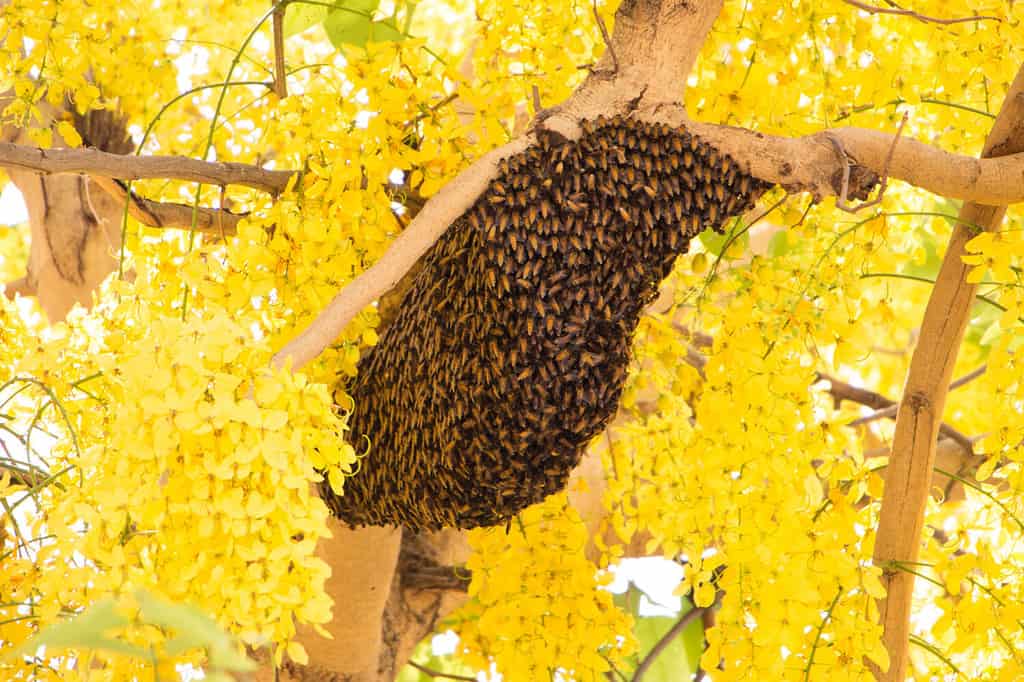
If the conditions are not ideal, honey bees will abandon their nest and find a better location.
©Infinity_Pok/Shutterstock.com
One of the reasons behind swarming is the need to move house, as bees may decide to abscond from their existing hive altogether. This drastic measure becomes necessary when several factors jeopardize the colony’s survival.
One such factor that can trigger an absconding swarm is a lack of essential resources like food and water. Bees rely on a steady supply of nectar and pollen for sustenance, but if their surroundings fail to provide sufficient nourishment, they are compelled to seek a more suitable habitat elsewhere. Similarly, parasite or disease infestations can ravage a hive and force the bees to abandon it in search of healthier surroundings.
Frequent disturbances by humans or animals can also disrupt the delicate balance within a bee colony, prompting them to evacuate their homes. Whether it be constant interference from curious passersby or predators persistently raiding the hive, these disturbances create an environment of stress and instability for the bees.
Weather changes play another crucial role in triggering swarming behavior among honey bees. Extreme fluctuations in temperature or prolonged periods of inclement weather can render their current habitat unsuitable for survival. In response, the bees initiate swarming as means of finding more favorable conditions where they can thrive.
Poor ventilation within the hive poses yet another challenge that might lead to swarming actions. Adequate airflow is vital for maintaining optimal humidity levels and preventing heat buildup inside the colony. Therefore, if ventilation is poor, they will abandon their nest for a better one.
Swarm Preparation
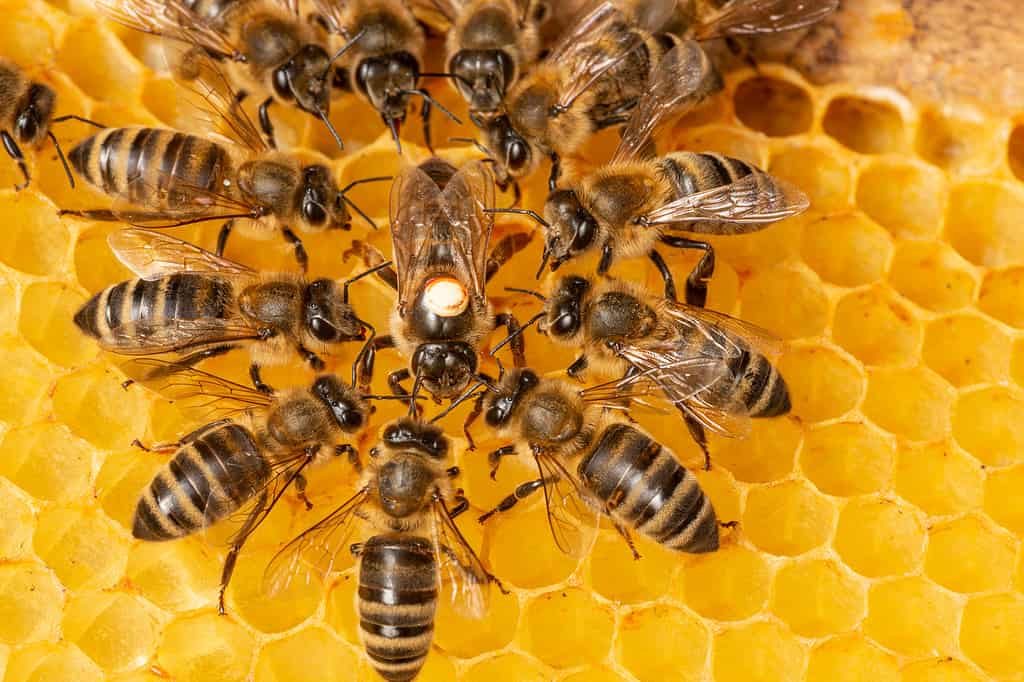
The queen (Apis mellifera) is marked with a dot and she has guardian bees around her.
©Kuttelvaserova Stuchelova/Shutterstock.com
Worker bees construct queen cups all year long, and when the hive is prepared to swarm, the queen lays eggs in those cups. This causes the brood cycle of the original colony to be interrupted. When the swarm emerges from the hive, it may only fly a few dozen feet away and form a cluster around the queen. Scout bees are then sent out to find a suitable new nest location, and the swarm will leave their intermediate stop within a few hours or days, depending on the excitement level of the scout bee’s dances.
Why Swarming is Dangerous for Bees
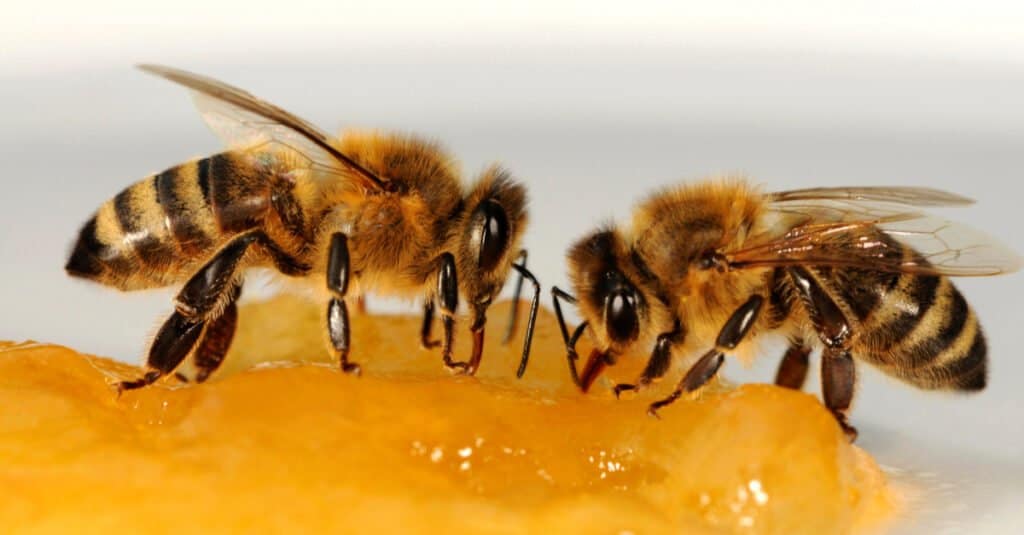
Did you know that honey is meant to be eaten by honey bees, not eaten by humans?
©schubbel/Shutterstock.com
Swarming, while a natural behavior for honey bees, poses significant risks and challenges for their survival. This collective exodus from the hive creates a vulnerable time in the life of these industrious insects. When a swarm forms, it consists solely of bees carrying nectar or honey reserves in their stomachs. Without finding a new home promptly and replenishing their food stores with more nectar, swarms face the imminent threat of starvation.
This peril is particularly heightened for early swarms that venture out on warm days only to be greeted by sudden shifts in weather conditions, such as cold spells or heavy rain during springtime. These unpredictable weather patterns can severely hamper the ability of swarms to secure adequate nourishment, making them even more susceptible to starvation.
After undergoing one or multiple instances of swarming, the remaining colony usually boasts ample provisions to sustain itself. However, there are various factors that can imperil its chances of survival. The newly emerged queen may encounter unfortunate circumstances during her crucial mating flight. She could become lost or fall prey to predators lurking in wait. Additionally, adverse weather conditions might impede her mating flight altogether.
When such misfortunes occur and hinder successful queen reproduction within the hive’s remnants, disaster looms ominously overhead. Without any further young brood available to raise additional queens, its chances of surviving diminish significantly.
What To Do If You See a Swarm of Bees
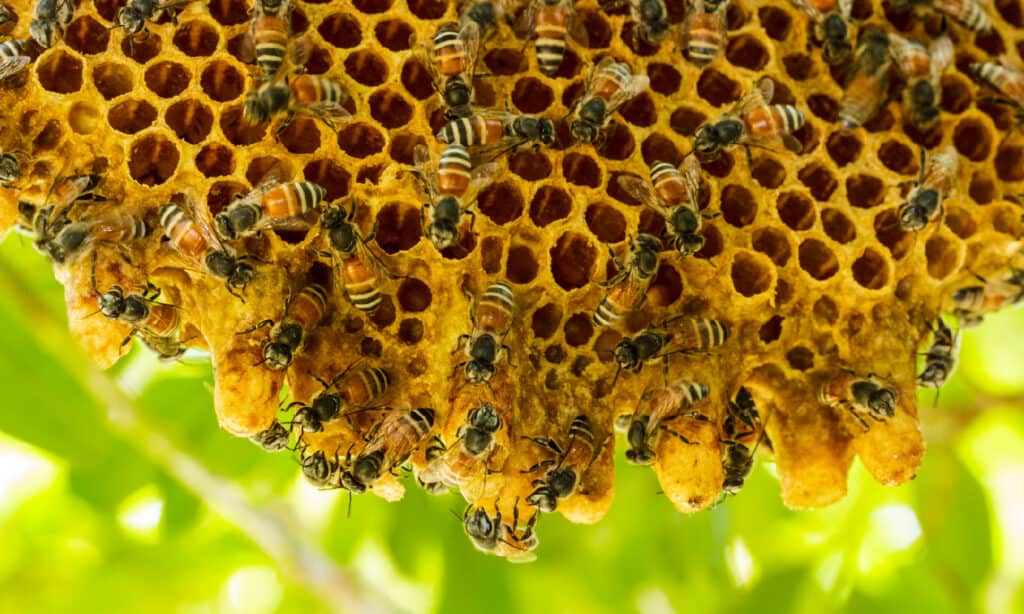
During a swarm, honey bees are at risk. They are at their most vulnerable during this time.
©iStock.com/nayneung1
So, what can we do about a swarm of bees? The first thing to remember is that if you leave the bees alone, they will most likely leave you alone as well. Swarming is actually a natural process in the life cycle of honey bees, and it serves as a means for them to reproduce and create new colonies.
It may seem alarming at first sight to witness such a spectacle, but rest assured that swarming honey bees are generally not aggressive or interested in stinging humans unless provoked.
The good news is that swarms usually don’t stay in one place for long. As social insects with highly efficient communication systems, scout bees quickly fan out to locate suitable sites for their future home while others protect the clustered swarm. Within just a few hours or up to three days at most, these intrepid scouts guide the entire swarm toward an appropriate location where they can build wax combs and settle down.
In most cases, honey bees choose tree cavities, light poles, or empty buildings as their preferred nesting spots. However, sometimes they may decide on less desirable locations such as inside walls of homes or garden sheds. This can understandably be quite bothersome. To prevent unwanted bee colonies from taking residence, keep all crevices and holes sealed to prevent them from moving in.
How to Remove a Bee Swarm
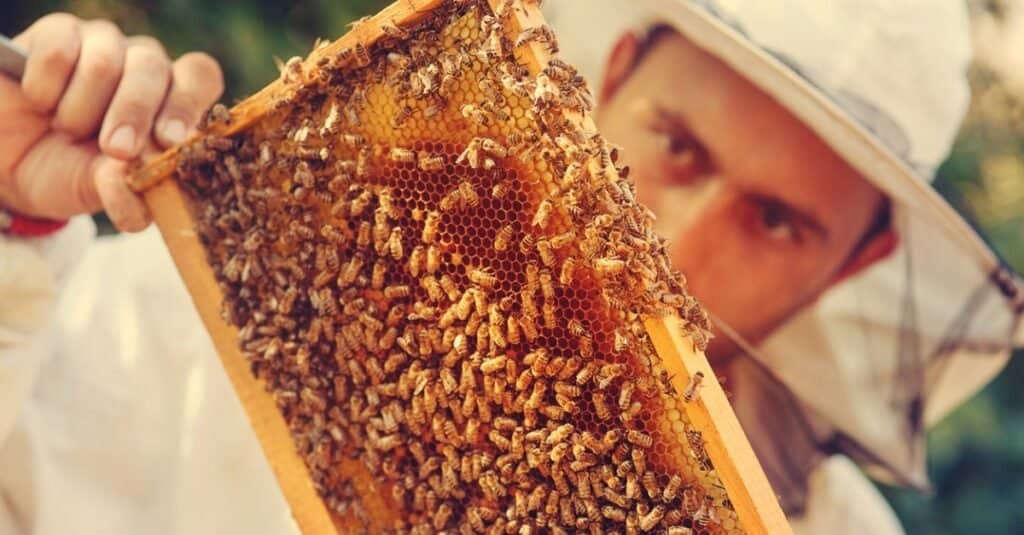
A professional beekeeper can safely remove a beehive or swarm from your property, without harming the bees.
©iStock.com/djiledesign
If you find yourself faced with the presence of a honeybee swarm and are unsure of how to handle the situation, reach out to a professional beekeeper. These experienced individuals possess the necessary knowledge and skills to safely remove these swarms, often for a reasonable fee or even free if they happen to be in close proximity.
One might wonder why hiring an expert is crucial when dealing with bee swarms. The answer lies in their ability to not only collect these swarms alive but also relocate them effectively. A competent beekeeper or specialized bee removal company possesses the expertise required to ensure the well-being of these vital pollinators while simultaneously addressing any concerns related to their presence.
It is important to note that exterminating a honeybee swarm should always be considered an absolute last resort. Given their irreplaceable role in our ecosystem and food supply chain, preserving and protecting honeybees becomes paramount. By contacting a professional, you contribute directly towards safeguarding both local ecosystems and our collective survival on planet Earth.
10 Reasons Why Humans Need Bees
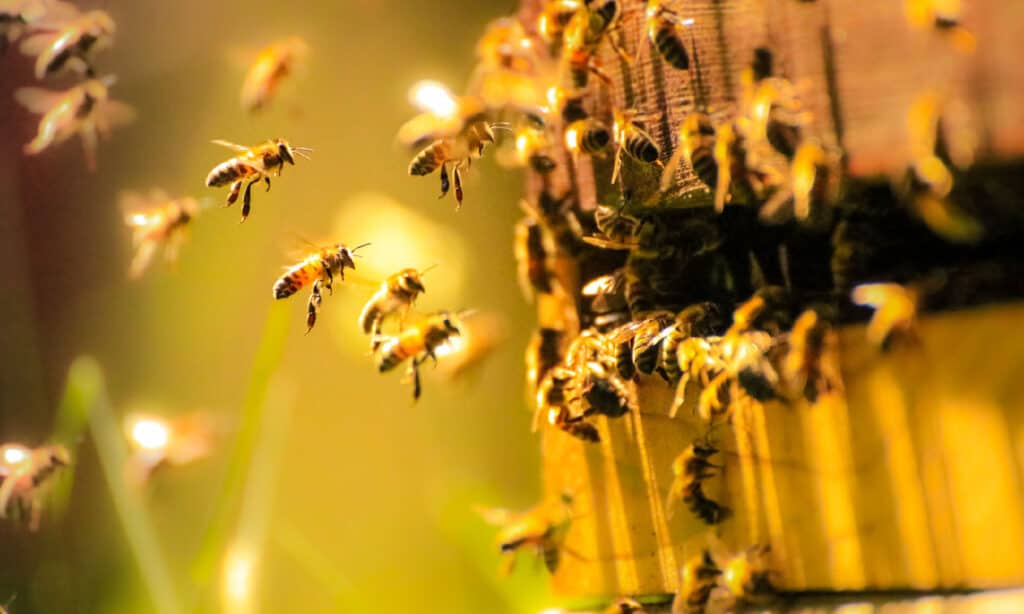
Bees are very important creatures that help keep humans alive. Thank you, bees!
©iStock.com/William Jones-Warner
- Bees pollinate approximately 90 percent of our crops globally.
- Many of our favorite fruits and nuts, such as cherries, almonds, apples, and blueberries, wouldn’t exist without bees.
- Bees make honey, which provides humans with a sweet, natural treat.
- Bees help to maintain a healthy, balanced ecosystem.
- Bees provide humans with a natural form of pest control.
- Pollination of flowering plants.
- Provide a source of food for other animals
- Improve soil health.
- Contribute to a healthier planet by reducing greenhouse gas emissions.
- Help create many medicines.
The photo featured at the top of this post is © Dave Hansche/Shutterstock.com
Thank you for reading! Have some feedback for us? Contact the AZ Animals editorial team.







